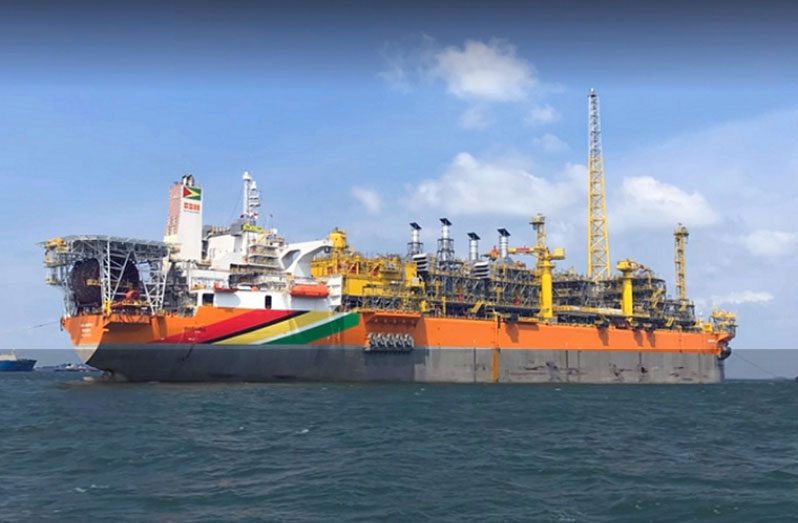IN just two weeks, Guyana will again benefit from its burgeoning petroleum sector, as the country is in line to receive its sixth oil lift.
The buyer of this lift is yet to be announced, but Minister of Natural Resources, Vickram Bharrat, has confirmed that the country will receive its sixth oil lift from ExxonMobil’s Liza Phase One operation in just two weeks. Since 2015, ExxonMobil, operator of the Stabroek, Canje and Kaieteur Blocks offshore Guyana, has increased its estimated recoverable resource base to more than nine billion oil-equivalent barrels. ExxonMobil’s first offshore Guyana project, Liza Phase One, began producing in late 2019, well ahead of the industry average for development time. Liza Phase Two remains on track to begin producing oil by early 2022. Liza Phase Two will produce up to 220,000 barrels of oil per day at peak rates, using the Liza Unity FPSO. Recently, the oil giant, following an agreement with the Government of Guyana, decided to proceed with the Payara field development offshore Guyana.
Those operations are all ongoing in the Stabroek Block, which is 6.6 million acres (26,800 square kilometers). There have so far been 18 discoveries on the block, and these have established the potential for at least five floating production, storage and offloading (FPSO) vessels producing more than 750,000 barrels of oil per day by 2026. It was early this month that Guyana last benefitted directly from the sector, receiving US$61,090,968 (approximately GYD$13B) from the sale of the nation’s fifth oil lift. The fifth lift was sold to New York-based Hess Corp, which in turn vended the local crude to HPCL-Mittal Energy Ltd (HMEL), a joint venture between State-run Hindustan Petroleum Corp and Indian steel tycoon LN Mittal.
It was reported that HMEL operates a 226,000 barrels per day ‘Bathinda’ refinery in the northern state of Punjab.
VOLATILE MARKET
Prior sales of local crude, particularly the first three, went to a trading arm of Shell on a dated ‘Brent’ basis. The oil market is volatile, but Brent price is listed currently as US$63.61 per barrel of oil.
Guyana, new to the petroleum sector, sold its first one million barrels of crude on February 19, 2020, raking in nearly US$55 million. In its second million-barrel sale, the country received US$35 million, US$46 million as proceeds from the sale of its third million-barrel of crude, and US$49.3 million from its fourth oil lift.
Based on a consolidation of all the lifts to date, the country has sold 5,009,797 barrels of oil valuing US$246,542,662.
Along with the earnings from the oil lifts and over US$21 million in royalties and interest, Guyana has close to US$267,668,709 in its NRF, at the U.S. Federal Reserve Bank. Under the Production Sharing Agreement (PSA), Guyana receives two per cent royalty and 50 per cent profit oil, which is what remains after the producer recovers the production cost.
Vice-President, Bharrat Jagdeo, had said no money from the fund will be used until the government amends or repeals the existing NRF Act. The government had committed to addressing important issues of transparency and ensuring systems and institutions are in place before those funds are utilised.
Sections of the media also reported President, Dr. Irfaan Ali, as saying Guyana’s oil revenue will remain untouched until a series of reforms are enacted to strengthen the government’s regulatory infrastructure for the oil and gas sector.
It was reported, in August last year, that oil revenues must be used to build the economy of the future which must feature supportive infrastructure such as good transport, deep-water harbours and modern airports as well as to strengthen the productive sectors.
“The oil resources have to be spent in a fashion that doesn’t create the Dutch disease where relative prices are changed and kills the competitiveness of other sectors,” Vice-President Jagdeo had said.
He said too that oil revenues will be spent to improve the lives of the citizenry and government will pass local content legislation that will address the issues of the business community and ordinary Guyanese.
Already, a draft local content policy has been developed, and this includes a series of phased targets for improved local participation, benefits and general advancement across all sectors, which will be achieved within the next 10 years, should the timeline remain unamended at the end of the ongoing national consultation exercise.
The overarching aim, as outlined by the government, is to create a policy which guides and regulates local participation in existing and emerging sectors.
This policy and subsequent legislation must be responsive to change and provide the ‘space’ to accommodate expansions in an economy such as Guyana’s, where there has been an increase in investors’ interest.




.png)









